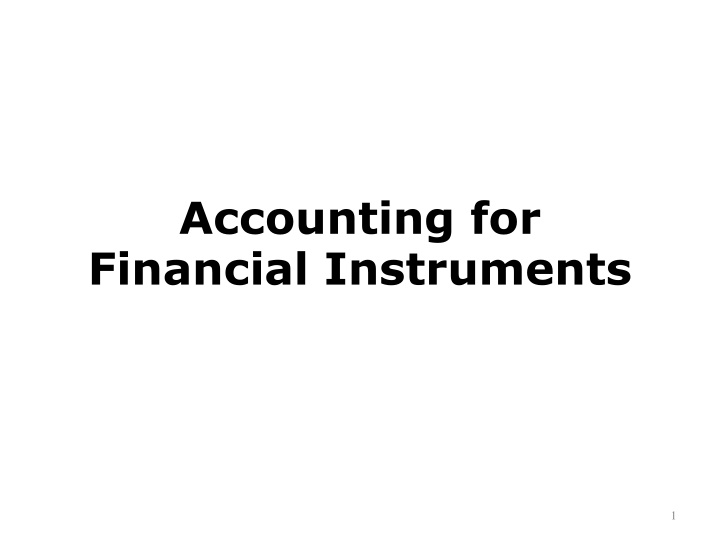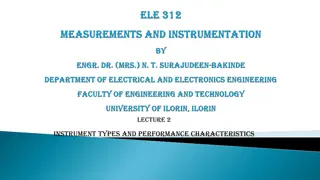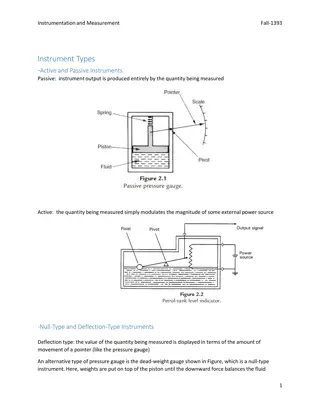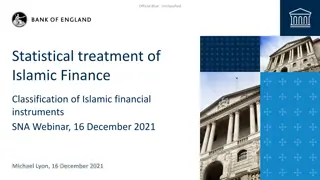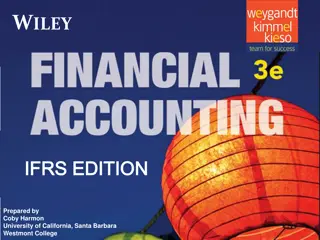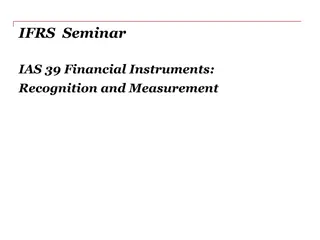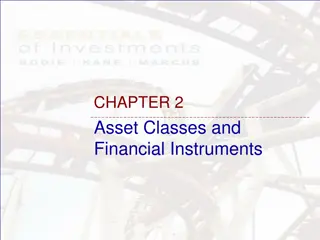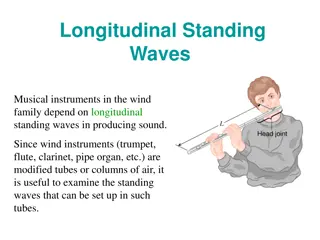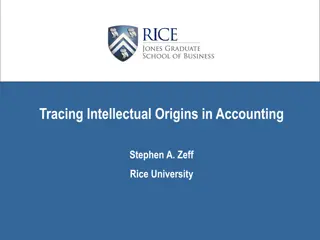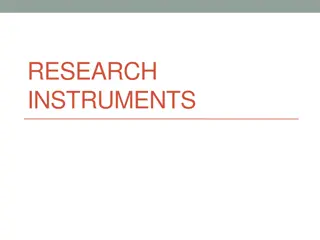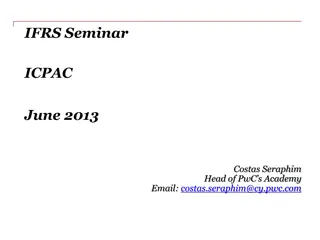Accounting for Financial Instruments Overview
This content provides an overview of accounting standards for financial instruments, including definitions of financial assets, liabilities, and equity instruments. It covers SLFRS 9, LKAS 39, LKAS 32, and SLFRS 7, discussing the recognition, measurement, presentation, and disclosures of financial instruments.
Download Presentation

Please find below an Image/Link to download the presentation.
The content on the website is provided AS IS for your information and personal use only. It may not be sold, licensed, or shared on other websites without obtaining consent from the author.If you encounter any issues during the download, it is possible that the publisher has removed the file from their server.
You are allowed to download the files provided on this website for personal or commercial use, subject to the condition that they are used lawfully. All files are the property of their respective owners.
The content on the website is provided AS IS for your information and personal use only. It may not be sold, licensed, or shared on other websites without obtaining consent from the author.
E N D
Presentation Transcript
Accounting for Financial Instruments 1
SLFRS 9 Financial Instruments (Replacement of LKAS 39) LKAS 39 Financial Instruments: Recognition and Measurement LKAS 32 Financial Instruments: Presentation SLFRS 7 Financial Instruments: Disclosures Accounting Standards on Financial Instruments 2
Financial Instrument Definition (32.11) Any contract that gives rise to both a financial asset of one entity and financial liability instrument of another entity. or equity 3
e.g. deposits of cash, debt investments, equity investments, receivables/payables Primary Types of Financial Instruments e.g. options, forwards/futures, swaps, caps and collars Derivative e.g. convertible bonds, equity indexed notes, exchangeable debt Compound 4
Financial Asset Definition (32.11) Is any asset that is: a) Cash; b) An equity instrument of another entity; c) A contractual right: i. to receive cash or another financial asset from another entity; or ii. to exchange financial assets or financial liabilities with another conditions that are potentially favourable to the entity: or entity under 5
Financial Liability Definition (32.11) Is any liability that is: a) a contractual obligation: i. to deliver cash or another financial asset to another entity; or ii. to exchange financial assets or financial liabilities with another entity under conditions that are potentially unfavourable to the entity; or 6
Equity Instrument Definition (32.11) Any contract that evidences a residual interest in the assets of an entity after deducting all its liabilities. 7
Presentation of Financial Instruments The issuer of a financial instrument should classify it or its component parts, on initial recognition as a financial liability, a financial asset or an equity instrument in accordance with the substance of the contractual arrangement and definitions of these instruments. (32.15) 8
Critical Features - Differentiating between Financial Liabilities and Equity Contractual payment obligations (Para. 32.23 ) e.g. Interest payments, repayment of debt Contractual components of a financial instrument that creates a financial liability of the entity (32.28-32 ) e.g. convertible bonds 9
Critical Features - Differentiating between Financial Liabilities and Equity (Contd.) A financial instrument may require the entity to deliver cash or another financial asset in the event of the occurrence or non occurrence of uncertain future events that are beyond the control of both the issuer and the holder of the instrument (Para. 32.25) e.g. change in a stock market index, consumer price index 10
Compound Financial Instruments (32.28) Financial instruments that contain both a liability and an equity component. Such components shall be classified separately as financial financial assets or equity instruments in accordance with Paragraph 15. liabilities, Amounts allocated to these debt and equity two components are based on their relative fair values at issuance. 11
Conversion of a Convertible Instrument at Maturity The entity derecognizes the liability component and recognizes it as equity. The original equity component remains as equity. There is no gain or loss on conversion on maturity. 12
Interest, Dividends, Losses and Gains(Paragraphs 35-41) If relating to a financial liability If relating to an equity instrument Recognized in income or expense in profit or loss net of any related income tax benefit. Debited directly to equity net of any related income tax benefit. 13
Derivative (39.9) A financial instrument with all three of the following characteristics: Its value changes in response to the change in a specified rate or price (underlying instrument) It requires no initial investment or an initial net investment. It is settled at a future date. 14
Forward Contract A firm buys a forward contract on US dollars from a Bank. Exchange US $ 100,000 for AUS $ 120,000 on 30.06.2015. Value of the contract depends on value of dollars. 15
Share Options Call Option Put Option Right to buy shares at a specified price (exercise/strike price) within a specified period (The option period). Right to sell shares at a specified price (exercise/strike price) within a specified period (The option period). 16
Swaps Interest Rate Swap Currency Swap Loan denominated in one currency is swapped with a loan denominated in another currency. Fixed interest rate obligation swapped for a variable rate obligation. 17
Caps and Floors (Interest Rate Options) Interest Rate Cap (interest rate ceiling) Interest Rate Floor An interest rate cap willcompensate the purchaser of the cap if the interest rates rise above a predetermined rate (strike rate). An interest rate agreement in which payments are made when the reference rate (benchmark rate) exceeds the strike rate (agreed rate). Aninterest rate agreement in which payments are made when the reference rate falls below the strike rate. An interest rate floor will compensate the purchaser if rates fall below a predetermined rate. 18
Embedded Derivative A component of a hybrid (combined) instrument that also includes a non- derivative host contract with the effect that some of the the combined instrument vary in a way similar to derivative. (39.10) cash flows of a stand-alone It is a derivative embedded in a host contract. (e.g. put instrument, interest rate swap embedded in a debt instrument ) option in a debt 19
An embedded derivative should be separated from the host contract and accounted as a derivative only if : economic characteristics and risks of the embedded derivative are not closely related with those of the host contract; a separate instrument with same terms as the embedded derivative would meet the definition of a derivative; and the hybrid instrument is not measured at fair value with changes in fair value recognized in profit or loss (i.e. derivate embedded in a financial asset or liability at fair value through profit or loss is not separated) (Paragraph 39.11) 20
Embedded Derivative (Contd.) Bifurcation (splitting) of embedded derivatives is eliminated for host financial assets. One classification approach is adopted (SLFRS 9, paragraphs 4.1.1 to 4.1.5) Questioned whether the embedded derivatives together with the host instrument meet the contractual cash flow characteristics test. If yes , hybrid contract as a whole qualifies for amortized cost classification If no hybrid contract as a whole is measured at fair value. 21
